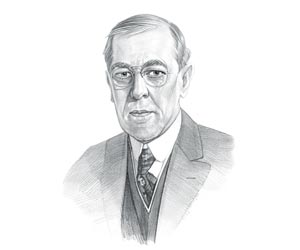|
|
|
|
|
At first, President Woodrow Wilson was reluctant to give the War Industries Board (WIB) much authority over the economy but this changed in March 1918 when Bernard Baruch, a Wall Street stockbroker, was appointed to run it. The WIB encouraged companies to use mass-production techniques to increase efficiency and eliminate waste by the standardization of products. Facts about
War Industries Board - WIB WW1 began in Europe on July 28, 1914. The United States adopted a policy of neutrality at the start of the war and did not enter conflict until April 6, 1917. The War Industries Board (WIB) was a government agency that was created on July 28, 1917 during World War 1. The purpose of the WIB was to coordinate the role of American industry during WW1 reorganizing and streamlining war-related industry through the management of resources, production, and distribution President Woodrow Wilson was reluctant to give the WIB much authority over the economy but this changed in March 1918 when it was realized that war industries needed to become more efficient. Bernard Baruch, a Wall Street stockbroker, was appointed to run the WIB. Bernard M. Baruch (1870–1965) was a wealthy Wall Street broker who had supported Woodrow Wilson's presidential campaign and served as an economic adviser during World War I (1914–1918). The WIB consisted of a number of different divisions that included responsibility for prioritizing the use of raw materials, conservation and regulating prices. Under the supervision of Bernard M. Baruch , the WIB controlled the flow of raw materials, told manufacturers what they could and could not produce, authorized the construction of new factories and with the president’s approval, set prices. While the WIB was in place, industrial production in the US increased by an estimated 20%. The WIB applied price controls at the wholesale level but retail prices soared. In 1918 Americans were paying almost double what they had paid before the war. Corporate profits soared in industries such as steel, oil, chemicals and meatpacking. Other US Government agencies were created during WW1 to regulate the economy and special boards were established to encourage cooperation between the government and big business. ensuring efficient use of national resources to further the war effort. The Federal Mobilization Agencies were established to compliment the work of the WIB and WW1 Mobilization. The WIB achieved greater economic efficiency through the rationalization of industrial practices. World War 1 ended on 11 November 1918 and the WIB was terminated by executive order on 1 January 1919. |
| US American History |
| 1913-1928: WW1 & Prohibition |
|
|
|
|
|
First Published2016-04-19 | |||
|
Updated 2018-01-01 |
Publisher
Siteseen Limited
| ||
|
|

